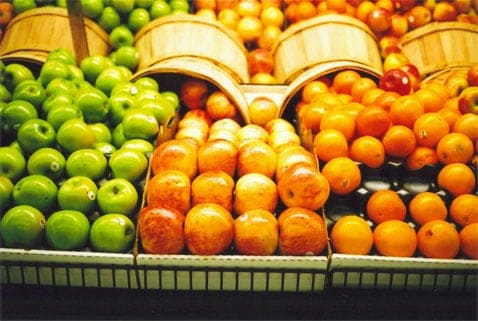Finding ways to save money takes a great deal of time. Matching up coupons with local sales, finding products online through advertisement, joining discount clubs, and discussing shopping tips with friends all consume time throughout the week. Here are a few tips to help you save money on your grocery bill.
Quick Navigation
Buy in Bulk
Buying in bulk can be misleading if you would not typically consume a large quantity of a product, but if you do use a lot of a product such as toilet paper, paper towels, shampoo, conditioner, coffee, or dry goods then it may be beneficial to buy in bulk. Bulk prices are comparable to many sale prices and buying direct can save even more. The biggest savings will come with time. If you plan to shop for these items you use continuously throughout the month then buying enough to last 30 to 60 days will reduce the time and cost of shopping each week.
Many online stores offer better prices in bulk and shipping cost is minimal, often less than the cost of time and fuel you would spend to drive to the store on numerous occasions. One example is shopping online at Meijer. Meijer offers thousands of popular items for delivery and even provides sale items on a weekly basis. Promotions are offered to encourage special savings with online sales. Percent off discounts, free shipping promotions, and better pricing methods help to offset the cost of shipping if it is not free. Other stores offer online shopping as well such as Sam’s Club, Wal-mart, Albertsons (select locations), Peapod (select locations), and AULSuperstore.
Plan Ahead
Plan ahead if you are going to shop weekly or online. Just because you still have half a bottle of ketchup doesn’t mean you shouldn’t buy any this week. Plan to buy products in advance while they are on sale or when you have a coupon. This will reduce the need to run out for just a few items and it will also reduce your long-term cost of food. If you don’t have a large pantry area in your home or apartment you can purchase storage containers to fit under your bed, in your closet, or even a storage cabinet for your garage. Keeping items you have purchased in a safe location is key to keeping your items usable. Make sure canned foods are in a safe location where they will not get dented or rust and keep dry foods such as cereal and cake mixes in a temperature controlled area.
Rotate Your Stock
Working on a first-in first-out basis doesn’t always work. You have to keep track of the dates of your products so you are not purchasing items when they are less expensive and never using the items. Mixes such as for cakes, pancakes, and muffins typically have long shelf lives, but don’t get carried away and buy too many. If these products expire you may encounter mold growth that can be harmful if eaten by someone who is allergic.
When you are putting items in your pantry you need to bring the older items to the front and check the dates of the items in your cabinet. If you do this continuously then you will be aware of items with close expiration dates and you will also be able to tell if you need to purchase more or less of an item. You may find that an occasional item has found its way into your pantry 10 times and you only consume the product once or twice a year.
Keeping track of what you have and what you need will help to reduce the cost of your grocery bill by eliminating the unneeded items from your list. This money can be used for more necessary groceries.
Prepare your Produce
Getting plenty of fresh fruits and vegetables is essential for a healthy lifestyle, but buying produce once a week or once every two weeks can be difficult to maintain. If you purchase products requiring preparation such as washing, peeling, or slicing, then you should prepare those within a day of purchase. Wash lettuce and place in a lettuce crisper, rinse apples and place in the refrigerator, wash grapes and broccoli and store in air tight containers in the refrigerator, and slice peppers for their intended purpose (i.e. stir fry, etc.).
Preparing produce in advance will help you during the week when you are rushed to prepare breakfast, pack lunches, or make dinner. You can simply pull out the broccoli and toss in a wok with a little water or you can grab a bag of grapes to quickly add to your lunch. Having access to your fruits and veggies that are ready to be used will encourage you to consume them and waste less. The less food we waste the less of a cost our grocery bill will be.
Use Your Freezer For More Than Processed Foods
Often freezers are packed full of frozen, preprocessed, ready-to-microwave meals, but it can be used for more than that. Buying meat such as chicken, hamburger, and steak while it is on sale can greatly reduce your grocery bill. Meat is on sale frequently especially around the holidays. Take into consideration how many pounds your family will consume each week then determine the amount in 3 or 6 months. Purchase that amount of meat when the product is on sale and prepare it for freezing when you arrive home.
Hamburger and fish are often ready to use right out of the store package and can be frozen as is, but chicken and other poultry need to be rinsed well before you use it. To save time, and ultimately money, prepare your chicken within two days of purchase. Rinse the chicken in cold water, remove any fat or unwanted pieces and discard, cut up the chicken for different meals (chunks or strips for stir fry, breast for baking, tenderloin strips for grilling, etc.). Then you can freeze the meat using a FoodSaver Vacuum Sealing System.
According to product claims, the FoodSaver saves up to $2700 per year based on buying in bulk, buying on sale, and not wasting food. Once the chicken is frozen you can quickly grab a bag out of your freezer, thaw it in the microwave, and cook it for dinner. Steaks can also be processed this way. You can purchase a large cut of meat to divide up for several meals reducing your overall cost of food. Rotate your stock in the freezer and use older items first to reduce waste. Preparing the meat in advance will encourage you to eat at home more, waste less food, and save dinning out for more special occasions.
Saving money on your grocery bill seems more important than ever. With tighter budgets and higher food cost every little bit helps. Once you get into a rhythm of where and when to buy products you will see the cost of your grocery bill decrease and the time you spend on saving decrease. Saving will become second nature and soon enough you will have extra money at the end of the month.





We use our chest freezer a ton for saving money on food. Just as an example we by fresh chicken breasts straight from a local meat market (you have to buy 50lbs at a time) and we save over $1.50 lb (saving $75 that we would have spent anyway) compared to the supermarket prices. We just freeze everything and pull it out of the freezer when we need it.
Ryan,
Having access to purchase meat directly can save money as you mentioned. If someone doesn’t live near a processing plant or distributor they can buy in bulk at wholesalers to save money. Although sale prices can often be less expensive than wholesale prices, so be smart and price compare before you buy. You can also save money by having a meatless meal at least once a week. Vegetable Stir Fry is a great alternative and reduces saturated fats from your diet.
Groceries are something that everyone should strive to save money on, since it is a necessity. Luckily, there are lots of daily deal sites to use out there to find discounts on food.
Some sites will let you look at all the deals in your area. One of these, http://www.dailydealpool.com, will compile all the sales and deals in your area and send them to your e-mail inbox daily, giving you a variety of products to look at and ensuring you won’t miss out on a great deal.
Having just completed our food pantry challenge of living off of what we had and not grocery shopping for a month, I am looking forward to getting back to the grocery store and your tips above will certainly help. One gimmick I try to avoid are the “10 for 10” type of sales. At the time they sound great but by the fourth night of cheese and broccoli rice you’re ready to scream. The price sounds great but if they end up sitting in the pantry until expiration, they were just a waste of money.
I agree! 10 for $10 are not always the best deals because some items typically sell for less than a dollar. Don’t shy away from this type of sale completely because some items are a great price at a $1 (Pepperidge Farm Gold Fish Crackers, bread, Philadelphia brand Cream Cheese, etc.). Check with your supermarket, but most of the time you don’t have to buy 10 of the same item to get the item for $1. You can often mix and match or simply by one of the items listed on sale.
These are some great tips! The best way to save money on your grocery bill is to know the real price and put money saving tips into action.
For some additional tips on how to shrink your grocery bill, check out the link below for 5 Ways to Save Money on Groceries:
http://gainmoneycontrol.com/5-ways-to-save-money-on-groceries/
Thanks for the tips. Finding new ways to save and combing sales with coupons can really reduce your cost. Planning ahead, making a list, and sticking to it can also contribute to lower grocery bills.
Keep your shopping list on your fridge. That way you can always mark when you run out of something and aren’t at the grocery store wondering if you have enough of an item. Also having an organized kitchen is easier to keep track of foods.
Jenna,
You make a great point. Having a place to store your shopping list such as your iPhone or Blackberry can help as well. People typically never leave home without those items so you will always have your list handy!
@Jeremy – True. However, I have a roommate so having an old school list works well for us since we don’t share our smart phones.